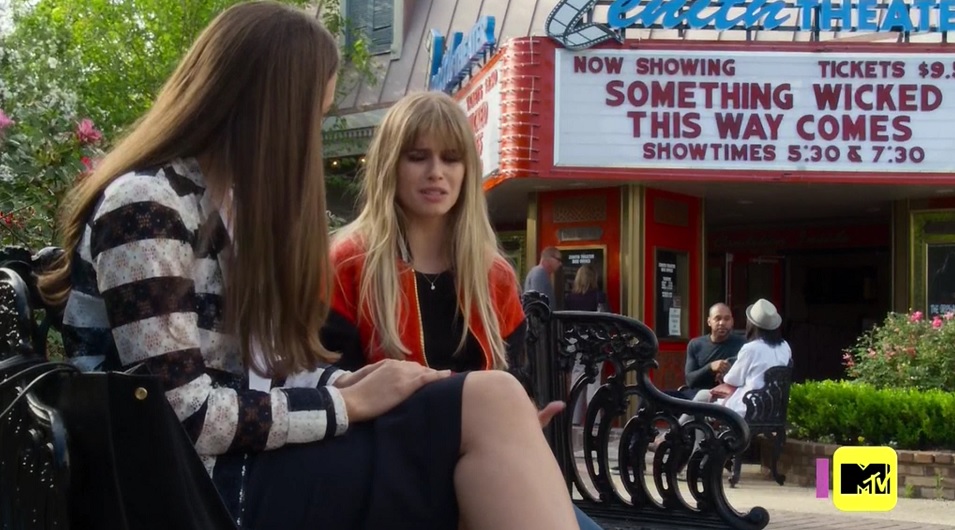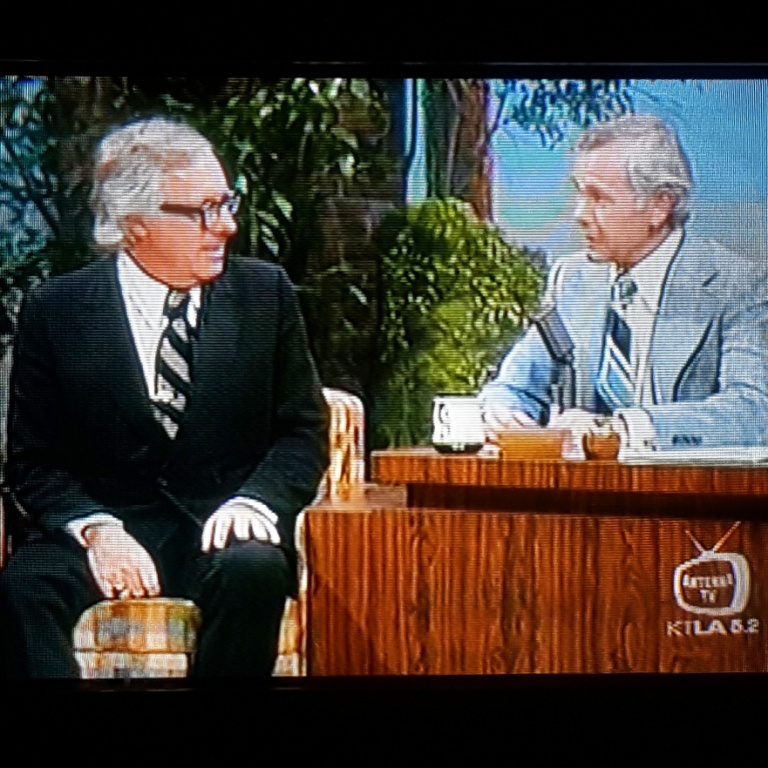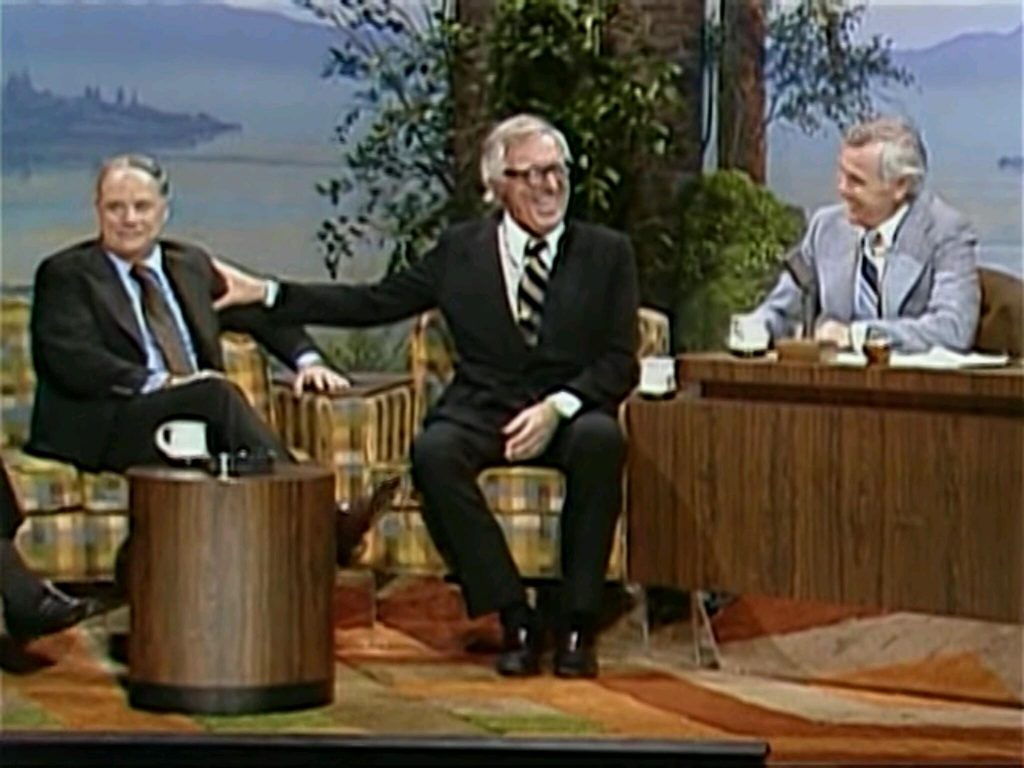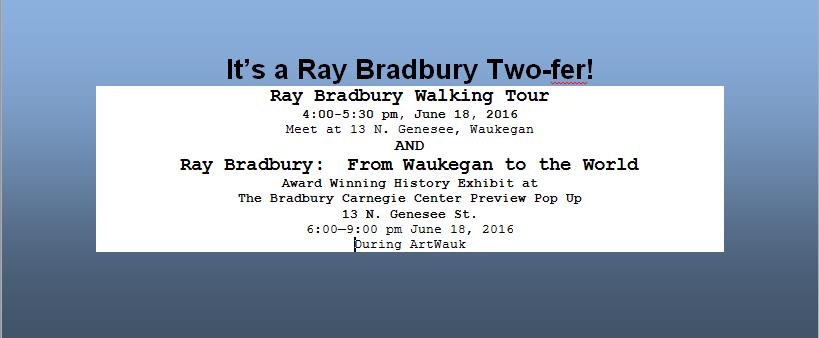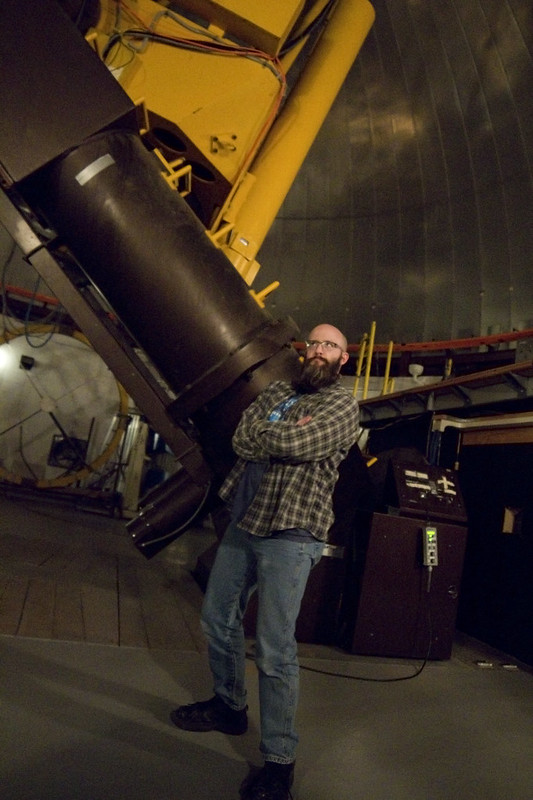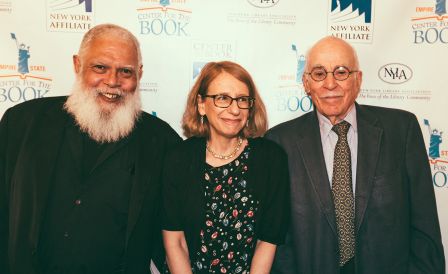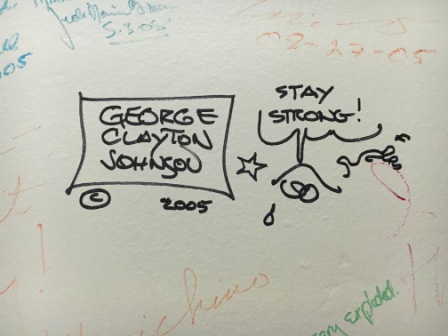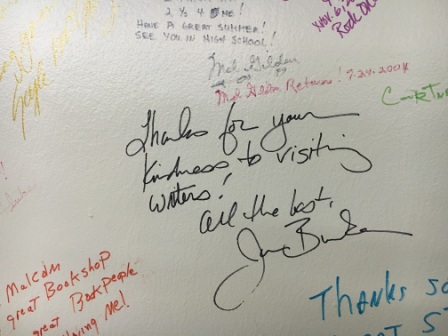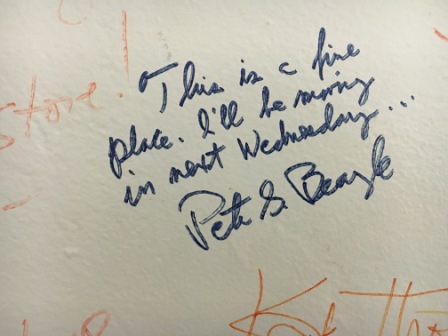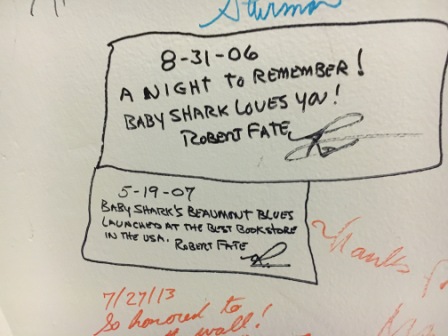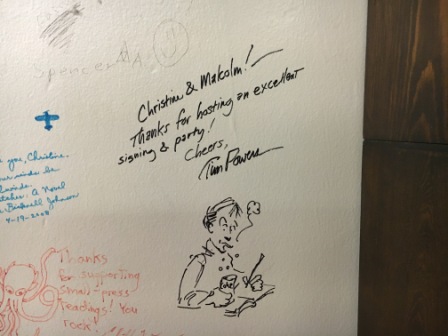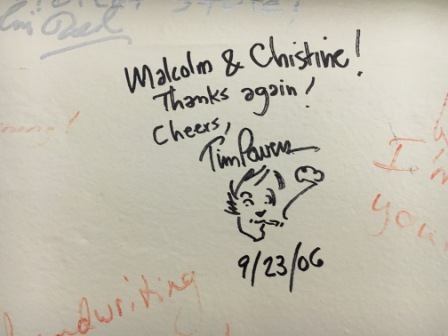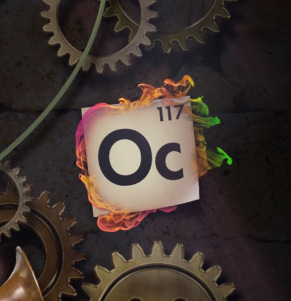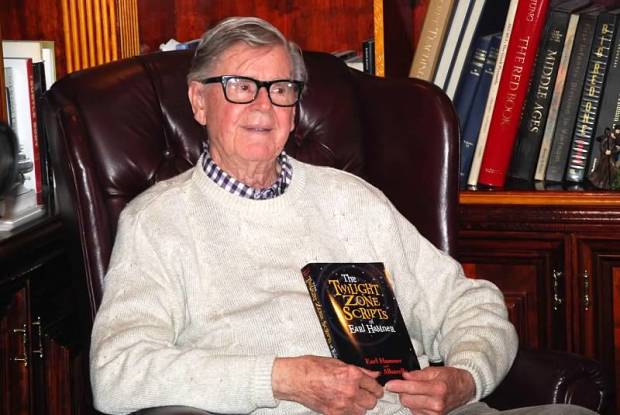Those were the days, my friends. Ray Harryhausen, Ray Bradbury and Forrest J Ackerman made a joint appearance at Bookfellows in Glendale in 2008. Not only are they all gone now, but so is the bookstore. Fortunately, the video lingers on!
Tag Archives: Mystery & Imagination Bookshop
Pixel Scroll 7/31/16 O You Who Turn The Wheel And Look To Scrollward, Consider Pixel, Who Was Once Handsome And Tall As You
(1) IT IS THE END MY FRIEND. My daughter went to the midnight Cursed Child book launch at her local store. She’d keep buying Potter novels if Rowling would keep writing them, but that is not in the works — “J.K. Rowling Says ‘Cursed Child’ Is the Last Harry Potter Story: ‘Harry Is Done Now’”.
The author, 51, spoke at the opening night of the Harry Potter and the Cursed Child stage play in London’s West End theatre district on Saturday, July 30, where she told fans that she’s finished with the series.
“[Harry] goes on a very big journey during these two plays and then, yeah, I think we’re done,” Rowling told Reuters on Saturday night. “This is the next generation, you know. So, I’m thrilled to see it realized so beautifully but, no, Harry is done now.”
(2) BEAM ME – OH, NEVER MIND. Steven Murphy of ScienceFiction.com canna stand the strain – of Star Trek’s inconsistent and underimaginative use of the transporter. He makes his case in “Star Trek and the Optimization of the Transporter”.
Does it bother anyone else that the characters of ‘Star Trek’ regularly overlook the obvious solution? They’re not stupid. I’d understand if they were stupid. They are among the smartest collection of people in fiction. They just have a huge blindspot: the power of teleportation.
In ‘Star Trek,’ transporters can dematerialize people or things in one location and rematerialize them elsewhere. I wouldn’t be the first to point out that the functionality of the technology maddening varies based on the requirements of the plot.
Murphy develops three main themes:
- The Federation Should Weaponize Transporters
- The Federation Should Use Transporters Defensively
- Transporters Should Be Used As A Warp-Alternative
(3) POLITICAL SF/F. Ilya Somin recommends “7 Fantasy/Science Fiction Epics That Can Inform You about the Real-World-Political Scene” at Learn Liberty.
Battlestar Galactica
The original 1970s TV series was remade in the 2000s. Both versions focus on the survivors of twelve human colony worlds that have been devastated by an attack by the Cylons, and both feature many of the same characters. Yet the original series and the remake are otherwise fundamentally different.
The former reflects a conservative response to the Cold War: the humans fall victim to a Cylon surprise attack because they were influenced by gullible peaceniks; the survivors’ military leader, Commander Adama, is almost always far wiser than the feckless civilian politicians who question his judgment. Concerns about civil liberties and due process in wartime are raised, but usually dismissed as overblown.
By contrast, the new series reflects the left-wing reaction to the War on Terror: the Cylon attack is at least partly the result of “blowback” caused by the humans’ own wrongdoing. The series stresses the importance of democracy and civilian leadership, and condemns what it regards as dangerous demonization and mistreatment of the enemy—even one that commits genocide and mass murder.
Both the original series and the new one have many interesting political nuances, and both have blind spots characteristic of the ideologies they exemplify. The sharp contrast between the two makes them more interesting considered in combination than either might be alone. They effectively exemplify how widely divergent lessons can be drawn from the same basic story line.
(4) DEL TORO COLLECTION. The Los Angeles County Art Museum exhibit “Guillermo del Toro: At Home With Monsters” opens August 1.
Guillermo del Toro: At Home with Monsters Guillermo del Toro (b. 1964) is one of the most inventive filmmakers of his generation. Beginning with Cronos (1993) and continuing through The Devil’s Backbone (2001), Hellboy (2004), Pan’s Labyrinth (2006), Pacific Rim (2013), and Crimson Peak (2015), among many other film, television, and book projects, del Toro has reinvented the genres of horror, fantasy, and science fiction. Working with a team of craftsmen, artists, and actors—and referencing a wide range of cinematic, pop-culture, and art-historical sources—del Toro recreates the lucid dreams he experienced as a child in Guadalajara, Mexico. He now works internationally, with a cherished home base he calls “Bleak House” in the suburbs of Los Angeles.
Taking inspiration from del Toro’s extraordinary imagination, the exhibition reveals his creative process through his collection of paintings, drawings, maquettes, artifacts, and concept film art. Rather than a traditional chronology or filmography, the exhibition is organized thematically, beginning with visions of death and the afterlife; continuing through explorations of magic, occultism, horror, and monsters; and concluding with representations of innocence and redemption.
(5) SOMETHING MORE TO VOTE ON. Still on that adrenaline high after voting for the Hugos? You can help James Davis Nicoll – he’s looking for readers’ opinions about the books he should review. He explains, “That specific set of reviews is of books I read as a teen, so between 1974 and 1981.” Register your choices in a “non-binding” poll” at More Words, Deeper Hole.
(6) AN IMPONDERABLES REVIEW. Dave Feldman enjoyed playing Letter Tycoon.
Once you get started, game play is remarkably fast and hassle-free. Letter Tycoon is a combination word game and stock market game. You form words using your own letters combined with three “community cards.” The longer the words you form, the more assets (in the form of cash and stocks) you earn. If you accumulate enough cash, you can buy patents in the letter(s) you have used to form your words. These patents function like houses and hotels in Monopoly; you get paid every time another player forms a word using “your” patented letters. As you’d expect, it costs more to buy a patent on the most frequently-used letters, but some more obscure letters possess special powers that can make them valuable.
(7) TOOLS THAT CHANGE THE TOOL USER. Matthew Kirschenbaum, author of Track Changes, asserts “Technology changes how authors write, but the big impact isn’t on their style”.
“Our writing instruments are also working on our thoughts.” Nietzsche wrote, or more precisely typed, this sentence on a Malling-Hansen Writing Ball, a wondrous strange contraption that looks a little like a koosh ball cast in brass and studded with typewriter keys. Depressing a key plunged a lever with the typeface downward onto the paper clutched in the underbelly.
It’s well-known that Nietzsche acquired the Writing Ball to compensate for his failing eyesight. Working by touch, he used it to compose terse, aphoristic phrasings exactly like that oft-quoted pronouncement. Our writing instruments, he suggested, are not just conveniences or contrivances for the expression of ideas; they actively shape the limits and expanse of what we have to say. Not only do we write differently with a fountain pen than with a crayon because they each feel different in our hands, we write (and think) different kinds of things.
But what can writing tools and writing machines really tell us about writing? Having just published my book “Track Changes” on the literary history of word processing, I found such questions were much on my mind. Every interviewer I spoke with wanted to know how computers had changed literary style. Sometimes they meant style for an individual author; sometimes they seemed to want me to pronounce upon the literary establishment (whatever that is) in its entirety.
(8) LOCUS POLL COMMENTS. At Locus Online you can read voters’ Comments from the 2016 Locus Poll and Survey. For example:
I actually read a couple of first novels I liked, which surprised me! I don’t read those very often these days, but these were strongly urged on me and I was pleasantly surprised. I’ve been reading e-books for about a year now and they’re starting to form a large chunk of my “book” buying in general, though I still buy more genre in print form than e-book. I’m buying a lot of the old classics in e-book (i.e., Ye Olde Deade Whyte Guys, like Twain, Shakespeare, Mary Shelley (;)) and some of the older sf/f/h titles as well. The “Great Distemper of 2015” left me with a dull ache behind my eyes and reminded me why I ducked out of the fannish aspects of SF 20 years ago or so. I fervently hope it goes away soon. I read more and liked more of what I read last year. There must be something wrong with me! (innocentlookicon) I’m trying very hard to work up my inner “Hey you kids, get off my lawn!” attitude about the state of SF, but I can’t.
(9) FINAL CHAPTER. A Los Angeles Daily News story about several LA-area bookstores facing closure.
Adryan Russ slips behind the counter at Bookfellows/Mystery & Imagination in Glendale to say goodbye to co-owner Christine Bell, who recently announced that her long-standing used bookstore will be closing at the end of August.
With a hug, the longtime customer wishes her well.
“To see this store have to follow the trends of today’s world, where we won’t be holding books much longer, you can see the sadness in her eyes about it,” says Russ, a musical theater lyricist based in Glendale. “It’s like a whole era is fading.”
The shuttering of Bookfellows comes as economic pressures from an increasingly competitive online marketplace, rising rents and dwindling walk-in traffic make it hard for some Southern California independent used booksellers to keep their large storefronts.
(10) ONE NY BOOKSTORE IS STICKING AROUND. The New York Times found a bookstore with an edge on the competition — “Want to Work in 18 Miles of Books? First, the Quiz”.
As Jennifer Lobaugh arrived at the Strand Book Store to apply for a job this spring, she remembered feeling jittery. It wasn’t only because she badly wanted a job at the fabled bookstore in Greenwich Village, her first in New York City, but also because at the end of the application, there was a quiz — a book quiz.
She rode the elevator to the third floor, sat down at a long table and scanned the quiz: a list of titles and a list of authors. She matched “The Second Sex” with Simone de Beauvoir right away. But then she had doubts. “I thought I would have no trouble,” said Ms. Lobaugh, 27, who has an M.F.A. in creative writing and a background in French and Russian literature. “But I got nervous.”
The Strand is the undisputed king of the city’s independent bookstores, a giant in an ever-shrinking field. It moves 2.5 million books a year and has around 200 employees. While its competitors have closed by the dozens, it has survived on castaways — from publishers, reviewers, the public and even other booksellers.
For nearly a century, the huge downtown bookstore has symbolized not only inexpensive books, but something just as valuable: full-time work for those whose arcane knowledge outweighs their practical skills.
Can you pass the Strand’s literary quiz? Match each book with its author. Test Your Book Smarts.
With a score of 33/50, I probably won’t be working at Strand until they start hiring folks whose specialty is asking, “Would you like fries with that?”
(11) TODAY IN HISTORY
- July 31, 1971 — Apollo 15 astronauts Dave Scott and Jim Irwin drove the first Lunar Roving Vehicle on the moon. Mental Floss writer Chris Higgins says:
It was the first time humans had experience driving on another world, and by all accounts, the LRV was awesome.
The LRV was used mainly to extend the astronauts’ travel range up to a few miles from the landing site (for Apollo 15, the LRV traveled more than 17 miles in total). This allowed the science-focused missions of Apollo 15, 16, and 17 far more reach than hoofing it around the moon’s surface.
Jerry Seinfeld also had something to say about driving on the moon:
(12) TODAY’S BIRTHDAY GIRL
- Born July 31, 1965 – J. K. Rowling
(13) TODAY’S BIRTHDAY WIZARD
- Born July 31, 1980 — Harry Potter
(14) GIANT ROBOTS. Kevin Melrose of Comic Book Resources thinks “Glorious ‘Transformers’ fan film is better than any of Michael Bay’s”.
Called “Generation 1 Hero,” it’s directed by Lior Molcho and stars members of Arizona Autobots, a group of Transformers cosplayers who create their own costumes. “Y’know, it was a lot of fun having them punch each other,” Molcho said in a behind-the-scenes video. “It’s a boy’s dream come true, y’know: giant robots punching each other! This is pretty awesome!”
(15) AN EDITOR’S ADVICE. Amanda S. Green’s post “It is a business”, quoted here the other day, attracted comment from the publisher of Castalia House, Vox Day in “Submissions and so forth”. His counsel begins —
- Most of the stuff that is submitted isn’t anywhere near ready. Seriously, we’re talking “WTF were you thinking” territory. Don’t submit just to submit, practice, then file it away if it’s not genuinely on par with what the publisher publishes and move on to the next work.
- You have VERY little time to impress the slush reader, who is wading through large quantities of writing that ranges from barely literate to mediocre. Make it count.
- Keep the cover letter short and to the point. No one is going to be impressed by how BADLY you want to be published or HOW MUCH you want to work with the publishing house. What you want has nothing to do with how good your book is.
(16) LARPOLOGY. The thirtieth installment of Marie Brennan’s Dice Tales column for Book View Café has the irresistible headline: “Every Title I Can Think of for This Post Sounds Like Spam”.
When you introduce a new character to an ongoing campaign, narrative integration is only one of the problems you face. The longer the game has been underway, the more you need to think about mechanical balance.
(17) LAST DAY OF VOTING. Peter J. Enyeart makes a fascinating assessment of Neal Stephenson while explaining how he ranked the nominees in the Best Novel category, but here’s who he thought should win —
- Ancillary Mercy by Ann Leckie In the closing novel of the trilogy, Breq faces ever greater challenges as she finds herself a high-value target in the Radchaai civil war. I feel a little bad about picking this one for the top spot, since it’s a sequel to a book that won two years ago, but it was definitely my favorite. It’s the only nominee I had read before the nominations were announced, and the only nominee that I actually nominated. I read the whole thing in about 24 hours, the week it came out. It even makes me feel more charitable towards the second installment in the series, which I liked less, because it serves as a nice set up for this satisfying conclusion. Breq is one of my favorite characters in fiction. So cold, aloof, detached, and calculating, and yet so empathetic, observant, devoted, and inspiring. It’s a tall order for a writer to pull off that combination, but she did it. Breq provides a model for leadership that seems like something a person like me could aspire to, and I’m very appreciative. (I like the Presger Translators a lot, too.) Well done, Ann Leckie.
(18) ANOTHER COUNTY HEARD FROM. Charon Dunn, on the other hand, put Stephenson’s novel first on her 2016 Hugo Ballot.
Seveneves
Earnestly focusing on books as they linearly progress from beginning to end is for noobs and editors and people like that. Sometimes you just want to dive into a ballpit of words and mosh around. Seveneves is one of those, hard science flavored, where humanity reaches the mostly dead state before seven intrepid spacewomen start cranking out babies, thus founding seven distinct races, each one bioengineered per their founding mother’s will. Setting the scene for future highjinks.
Many of the reviews I have read make a pointed effort at informing readers that the bioengineering in Seveneves is hogwash. A lot of my generation feels the same way about bioengineering that the Victorians did about sex, which makes it a fun taboo to read and write about. Sure it’s hogwash, so are Death Stars, who cares. The science in Seveneves follows this soothing cycle of looming disaster; implement solution; new looming disaster. I’m a fan of this method of plot organization.
(19) A NEW LEAF. And if you assumed that someone writing for a blog called Books & Tea would pick the book by the tea-loving Leckie, then Christina Vasilevski will surprise you with her choice, in “What I’m Voting for in the 2016 Hugo Awards”.
- The Fifth Season by N.K. Jemisin — As I mentioned when I read and reviewed this book last year, The Fifth Season blew me away. I’m so glad this one ended up on the ballot. Jemisin’s writing is lyrical and her willingness to put her politics front and centre in her stories is great.
(20) FAN ARTISTS. Doctor Science posted an overview of the Fan Artist nominees. Earlier, the Good Doctor covered Pro Artist.
(21) HOW DO YOU GET THIS OUT OF SECOND GEAR? Forbes’ infographic contrasts Star Trek’s warp drive with what scientists are working on today.
If you want to experience the thrill of travelling faster than the speed of light, all you need to do is hitch a ride on the Starship Enterprise and engage the ‘warp drive’. You’ll be able to enjoy a cup of hot Earl Grey while visiting countless worlds through interstellar travel, all thanks to the power of warp drive! Easy peasy.

[Thanks to John King Tarpinian, James Davis Nicoll, and Steven H Silver for some of these stories. Title credit goes to File 770 contributing editor of the day Ann Leckie.]
Bradbury Now and Then
BRADBURY EXAM. HowStuffWorks challenges fans to take “The Ultimate Ray Bradbury Quiz”, 30 questions that look easier than they are.
He wrote outlandish stories that taught concrete lessons in critical thinking and morality. How much do you know about Ray Bradbury?
IN THE BACKGROUND. J. W. Ocker sent a screengrab from the “Jeepers Creepers” episode of the MTV series Scream.
Two of the characters talk in front of a marquee that advertises Something Wicked This Way Comes. It foreshadows a climax at a closed-down carnival after dark.
Ocker is a Bradbury fan whose own nonfiction repertoire includes Poe-Land: The Hallowed Haunts of Edgar Allan Poe, and a book about living in Salem, Massachusetts — A Season with the Witch — coming out this fall.
THE BEST. Steven Paul Leiva remembers when Bradbury told him about his favorite bookstore.
When a great American author recommends a bookstore to you, you would be well-advised to listen. When he does it with enthusiasm and passion, which was the only way Ray Bradbury ever did anything, you would be well-advised not just to listen, but to take note — in indelible ink on acid free paper, on any recording device you have handy, and by any method of mnemonics you practice.
“Steve, you and Amanda must come to my book signing next Wednesday. But not just for me, it’s at one of the best bookstores ever, Mystery & Imagination in Glendale, great name, huh? It’s from Poe!”
WINDING DOWN. Unfortunately, that store is soon closing. (Mystery & Imagination is also “Bookfellows”). The LA Times paid tribute in “Bookfellows prepares to turn its last pages”.
In a glass case at the front of Bookfellows used bookstore in Glendale, a plush kitten once owned by Ray Bradbury is displayed beside a bottle of dandelion wine, and an autographed photo of Bradbury, Ray Harryhausen and Forrest J. Ackerman all together on the same stage. Next to that is a brick — one recovered from the ruins of the late author’s house after it was demolished.
One has to wonder if anyone will save a brick from Bookfellows when it no longer exists. The staircase in the back is a treasure trove of autographs from famous authors who’ve dropped by, from Mickey Spillane to Alan Young. Bradbury, disappointed that Harryhausen hadn’t drawn a dinosaur when he signed, drew a rough doodle of one next to the legendary animator’s name to put things right.
MORE 451. Richard Brody thinks its director badmouthed his “Movie of the Week: ‘Fahrenheit 451’”.
These days, directors are expected to talk up their films, and for good reason: it’s likely that François Truffaut’s remarks about his 1966 film “Fahrenheit 451” (which I discuss in this clip) are in large part responsible for the film’s wrongly low reputation. The film was something of Truffaut’s white whale: it took him four years to put the production together; along the way, he turned down some other significant projects, including “Bonnie and Clyde,” which the screenwriters Robert Benton and David Newman had written with him in mind. The shoot of “Fahrenheit 451,” which took place mainly in Great Britain, proved difficult for Truffaut, in part because he didn’t speak English, but above all because he had trouble working with the lead actor, Oskar Werner (who had played Jules in Truffaut’s “Jules and Jim”). Instead of keeping their conflicts out of the tabloids, Truffaut aired them himself: he kept a diary of the shoot and published excerpts from it in Cahiers du Cinéma.
HAWKING COFFEE. Believe it or not, Kirk Douglas and Ray Bradbury appeared together in a Japanese coffee commercial, filmed in Ray’s Beverly Hills office (probably 1981).
ON THE FRONT. Right after Bradbury passed away in 2012, Irene Gallo put together “Picturing Ray Bradbury”, a collection of cover art from his work, for Tor.com.
Ray Bradbury’s passing was a loss for everyone who enjoys storytelling in all of its forms. Not the least of which are artists and illustrators. Bradbury’s tone, the poetry and atmosphere of his worlds, have inspired artists for decades. Looking at his book covers, extending back over many printings, you see generations of artists reinterpreting the same works for their own era.
TONIGHT SHOW. John King Tarpinian recently saw a rerun of Johnny Carson’s Tonight Show first aired on March 1, 1978; Ray Bradbury was one of Johnny’s guests.
So was insult-comedian Don Rickles.
Tarpinian tells the story:
What is really impressive about Ray on Carson is…it may be the first time Rickles asked a serious question of a person on a panel.
On that show was Don Rickles, Ray was disappointed that Rickles did not give him a zinger. Afterwards Ray asked why he did not insult him, as anybody would have wanted. Rickles said he respected Ray too much and his final words were, “You hockey puck!” Ray walked away floating on air.
Bradbury Art Makes Headlines
(1) ENGINE 451. The Chicago Tribune ran photos — “New Waukegan train mural honors author Ray Bradbury”.
Pedersen said his work includes lots of trains, “but I had to have a design that was simple and would have an impact. I designed it so you could see what it was from 50 yards away.”
“It’s a universal image, everyone will recognize it’s a train,” Pedersen said. “I drew up the sketch and they liked it.”
Pedersen, who recently moved to Waukegan, said he enjoys the other murals around the city. He said he was walking down Sheridan Road when he noticed the wall and thought, “that would look a lot better with a mural.”
As a tribute to Waukegan author Ray Bradbury, Pedersen numbered the old engine 451 in honor of Bradbury’s book Fahrenheit 451.
(2) WALK IN WAUKEGAN. Bradbury’s birth city plans a walking tour and history exhibit next weekend.
(3) FATHER ELECTRICO. On Facebook, director John Sasser made a quick progress report about the documentary Father Electrico: Ray Bradbury Lives Forever, starring Ray Bradbury and sculptor Christopher Slatoff.
Today we completed the final edit of the film! Next up is to get the score complete and then it should be ready to start entering in film festivals.
(4) LETTER FROM IRELAND. For sale at Captain Ahab’s Rare Books, Ray Bradbury’s two-page TLS to Dolph Sharp, December 10, 1953.
Bradbury, Ray. TWO-PAGE TLS TO DOLPH SHARP, DECEMBER 10, 1953.Dublin: S.i., 1953. Letter typed on both sides of a single 5″ x 7″ sheet of blue gray stock; 48 lines (approx.300 words); signed “Ray” (in ink) next to the author’s small self portrait. Folded once, with tiny staple holes at margins; Near Fine. Offered together with the original, roughly-opened mailing envelope.
A wonderful early and revealing letter from a young Ray Bradbury to Dolph Sharp, written from the Royal Hibernian Hotel in Dublin, Ireland and mailed shortly after from Paris, France. Sharp was an author and long-time friend of Bradbury’s who ran a writers group which met in his Hollywood Hills home. Sharp’s daughter E.E. King recalls that shortly after 1948, “Ray Bradbury, Sanora Babb, Wilma Shore, Joseph Petracca, Elliott Grennard and Ben Maddow convened at our home in the Hollywood Hills and shared their stories over pastrami on rye…for over 30 years, they came to Blair Drive…Gathering around the coffee table, they would read their works and comment on one another’s projects. There were drinks and smokes and laughter…always laughter. I remember hearing Ray read the drafts of The Halloween Tree, which started as a painting, then became a short story, then a screenplay and finally a novel. Ray loved words. He was drunk on language. For thirty years, these were always the best of times in our house” (see: http://inkubate.com/history-of-the-writer-as-a-young-girl-2/). Bradbury presses Sharp for details on any progress or successes regarding his work and that of his fellow group members; “There were so many good stories coming there for a time, one after another; certainly one of them must have sold!” He goes on to relay his own progress at writing the script for John Huston’s adaptation of Moby Dick (1956); “I’ve written some 150 pages in order to finished [sic] 77 pages of useable script…Huston seems very happy with the work. Gregory Peck is coming over next Sunday for a visit; he’ll be Ahab, you know. Leo Glenn will be Starbuck.” Perhaps the most revealing passage relates to Bradbury’s disappointment at the reception of his first novel, which was released just two months in advance of this letter: “Will look forward to your opinion on FAHRENHEIT 451 when you have the time. It didn’t make the splash I rather hoped it might. But then – things never do work out quite as planned. I’m damn lucky anyway.” A charming and intimate letter, rich in detail, to a significant individual in the author’s creative circle; scarce thus. $1,950.00
(5) THE BIG READ. In LA, The Big Read continues to celebrate the author of Fahrenheit 451.
- 25 June, Saturday – 1:00 -4:00 PM
F451 TYPE-IN
Community celebration of creative typewriting, the process employed by Ray Bradbury to write his science fiction masterpiece, Fahrenheit 451. Louise Marler in partnership with THE BIG READ LA brings the F451 Type-In to Beyond Baroque again. The Big Read is a program of the National Endowment for the Arts in partnership with Arts Midwest. With multi-disciplinary arts and activities involving typewriters, all are welcome to bring their own typewriter, use one provided, write interactive poem, type thank you letters, etc. The afternoon will be full of inspired Reading, Writing, and Typing.
For more information visit organizer Louise Marler’s website here.
- 25 June, Saturday – 4:00 PM to 6:00 PM
THE BIG READ PRESENTS: FAHRENHEIT 451
The Big Read is a program of the National Endowment for the Arts in partnership with Arts Midwest.
www.NEABigRead.org Local writers and poets read selections from Ray Bradbury’s science fiction masterpiece, Fahrenheit 451. Featuring: Carlye Archibque, Greg Cope White, Anna Urena & more TBA! Free to all.
- 25 June, Saturday – 6:00 – 9:00 PM
F451 OPENING ART RECEPTION
A curated group of visual artists whose work centers on literature, language and typewriters will be on display simultaneously. In salute of the author’s work, Marler’s “Ray Bradbury TypOwriter” mixed media art is featured.
Bradbury’s 1947 Royal KMM typewriter art features a blazing writing machine surrounded by burnt text, inspired by “Fahrenheit 451.” This stunning work as well as the giclée limited-edition is offered for sale at the event with a portion of the sales being donated towards journalism scholarships through the Jim Murray Memorial Foundation.
Select Mexican students, inspired by reading “Fahrenheit 451,” artwork will be included with national and regional known artists. Free to all.
(6) ICE CREAM SUIT. South Pasadena will host a showing of The Wonderful Ice Cream Suit.
Screening of Ray Bradbury’s “The Wonderful Ice Cream Suit”, a Disney film, will be presented on Thursday, June 23 at 7:00 p.m. The Fantasy/Comedy/Drama stars Edward James Olmos, Joe Mantegna, Esai Morales, and Sid Caesar. Joe Mantegna will be on hand to introduce the film with his personal tribute to Ray Bradbury who helped start his professional acting career when he hired him for the theatrical version at the Organic Theatre in Chicago in 1974. Mantegna is currently the star of the popular, long-running CBS TV series “Criminal Minds.” Robert Kerr, from the Ray Bradbury Pandemonium Theatre Company, will offer his reflections of his experiences performing the play “The Wonderful Ice Cream Suit” at the Fremont Centre Theatre in South Pasadena with Bradbury in attendance. The Community Room, located at 1115 El Centro Street, will open at 6:30 p.m. The film is rated PG and is presented by the South Pasadena Public Library, the South Pasadena Arts Council (SPARC), and the Friends of the South Pasadena Public Library. Refreshments will be provided and no tickets or reservations are necessary. Special thanks to the Friends of the Rialto Theatre, David Marchan, John King Tarpinian, and David Lyons/Pro Outdoor Movies
(7) THOSE WERE THE DAYS. In February 2010, Mystery & Imagination Bookshop hosted the Bleeding Edge Signing, and the notables present that day can be seen in this video.
William F. Nolan stalks the aisles at 0:25. Earl Hamner Jr. arrives around 1:50. The first Bradbury sighting comes about 2:04. George Clayton Johnson at 2:30.
Norman Corwin sits to the right of Bradbury. Also in there: John Shirley, James Robert Smith, Cody Goodfellow, Lisa Morton, Earl Hamner, John Tomerlin, Dennis Etchison, John Skipp, Paul J. Salamoff, and Pete Atkins.
Pixel Scroll 6/12/16 But I Still Haven’t Scrolled Where the Pixels Are
(1) MAGIC STACKS. The Oxford University Press Blog gives “6 reasons why the Hogwarts library is the true hero of the Harry Potter books”.
…Alas, when our letter-bearing owl rudely pulls a no-show, accepting one’s muggle status is a hard pill to swallow. But, as today is Magic Day, we’ve decided to temporarily shelve our disappointment, and pay tribute to our favourite Hogwarts hotspot. Undoubtedly, the unsung hero of the Harry Potter series, we’re referring to a place with more answers than Albus, better looks than Lockhart, and even more mystery than Mad-Eye Moody. This is why we love the Hogwarts library…
It has screaming books.
Though, deep down, we’re rooting for Harry to succeed in his endeavours, given his complete disregard for the rules, we can’t help but feel a certain amount of satisfaction when one of his plans goes awry. As far as we’re concerned, any young scallywag who presumes to enter the restricted section of the Hogwarts library in the dead of night, without even attaining a teacher’s note of approval, deserves to happen upon a screaming book. On this particular occasion, we commend the library for thwarting this little rascal’s rebellious plans.
(2) THE PEEPS LOOK UP. Jim C. Hines has a gallery of 80+ photos taken at the recently completed Launch Pad Astronomy Workshop.
(3) PRICE POINTS. Fynbospress has another skull session for indie authors: “How much for the print book?”
How much should you charge for your print book?
The answer is: it depends. First, are you planning on getting wide sales of your print book, or is it just there to make your ebook page look more professional, and more of a bargain?
This is a serious question: indie pub is still small press pub (just one-author houses), and can get into libraries and brick and mortar shops. It just takes more work, and usually more lead time between finishing the books and publishing them. In some genres, especially nonfiction segments where a large portion of the revenue is from talks and print books sold at same, the print version is more important than the ebook price.
(4) NEXT YEAR’S CAPCLAVE. Elizabeth Twitchell, Chair of Capclave 2017, announced a GoH today — Neil Clarke, of Clarkesworld.
Clarkesworld Magazine’s work in promoting speculative short fiction makes him a perfect fit to join another Capclave guest, Ken Liu, as the con celebrates 10 years of the WSFA Small Press Award. The con will be held October 6-8, 2017 at the Gaithersburg Hilton.
(5) RAY HARRYAUSEN. He’s a fast worker.
[watch] Question Everything: Ray Bradbury and Ray Harryhausen on Curiosity https://t.co/UPlaYGrsxZ pic.twitter.com/28jJmizzv5
— One Perfect Shot (@OnePerfectShot) June 12, 2016
(6) INSIDE JOB. “Charmed: Fairy Tale Reform School Book 2” by Jen Calonita (Reviewed by Cindy Hannikman) at Fantasy Book Critic.
ANALYSIS: Flunked, the first book of the Fairy Tale Reform School series, was a fast, fun children’s novel. It followed the life of a young thief (Gilly Cobbler) who was caught and sent away to Fairy Tale Reform School. Fairy Tale Reform School is designed to help fairy tale character right their wrongs and learn how to become productive members of their respective fairy tales. After all, not everyone can be the hero, villain, or princess; some people do have to be the baker, cobbler, or famer.
Now, Charmed is the second book of the series and picks up shortly where Flunked left off. Alva (our big bad for the series and is a version of the evil fairy queen from Sleeping Beauty) has been locked up. Meanwhile Gilly Cobbler, who was once an overlooked young thief who is trying to reform herself, is now considered a hero for what she did in Flunked, but all is not well.
(7) NO PLACE LIKE HOME – BREW. Martin Morse Wooster is back.
I’ve just returned from three days in Baltimore with home brewers. I have always maintained that home brewers are the people most like fans who are not fans. The National Homebrewers Conference has a con suite during the day, known as “Social Club” where people can sit and drink home-brew. They have a masquerade, except it’s called “club night,” and the competition is between clubs, whose members dress up in costumes (Vikings and pirates were popular this year) and serve free beer.
There were two developments this year that made the convention more like a sf con than in the past.
- The name of the convention has formally been changed from “National Homebrewers Conference” to “Homebrewcon.”
- The home brewers have discovered silly badge ribbons. They haven’t gotten to the level of a Worldcon where you can get a generalissimo-sized stack of ribbons, but I saw at least two or three silly ribbons on some badges next to the serious ones for being a judge or being on the organizing committee. I never noticed anyone with more than four ribbons.
I also learned of the demise of one of the convention’s quirkier traditions. They used to give a prize, known as the Golden Urinal or “Pissoir D’Or”, to the club whose members brought the most number of kegs to the convention. In 2013, the Barley Legal Club of southern New Jersey (note to people from New Jersey–they’re “near exit 4”) showed up with 200 kegs and the trophy was retired. They brought the urinal to the convention, and I can now say I have drunk from the Golden Urinal on three occasions. And yes, it is a urinal painted gold.
Next year’s Homebrewcon will be from June 15-17 in Minneapolis.
(8) KASEY LANSDALE. Wynona’s opening act at the Canyon Club on June 17 is Joe R. Lansdale’s baby girl.
Now, WYNONNA and her band The Big Noise, led by her husband/drummer/prodcer, Cactus Moser, have released their debut full-length album to critical acclaim. Rolling Stone’s Stephen L. Betts raved, “Wynonna & The Big Noise brings a raw, unvarnished approach to the album’s dozen tracks, which run the gamut from gutsy blues to sweet, Seventies-inspired country-pop…. Wynonna’s legions of country fans will feel right at home.” Get ready, Agoura Hills, cause WYNONNA & The Big Noise are taking it on the road – and make their debut appearance on The Canyon stage.
Opening sets by ‘Michael-Ann’ and ‘Kasey Lansdale’
(9) INDY 5. “John Williams Will Score Indiana Jones 5 & Star Wars: Episode VIII” guarantees ComingSoon.
Last night, the American Film Institute held a red carpet event honoring legendary film composer John Williams (Jaws, Harry Potter, Superman) with a lifetime achievement award. The 84-year-old Williams, whose work on all four Indiana Jones films as well as all seven Star Wars Saga films are career-defining, took the opportunity to assure the world he would be back for Lucasfilm‘s next installments of both franchises.
“If I can do it, I certainly will,” Williams confirmed to Variety of his commitment to do the music for Rian Johnson’s Star Wars: Episode VIII, currently in the home stretch of filming. “I told Kathy Kennedy I’m happy to do it, but the real reason is, I didn’t want anybody else writing music for Daisy Ridley.”
Meantime, during an interview with Empire Magazine about his new movie The BFG, Spielberg confirmed a MacGuffin has been selected for Indy 5:
“(Steven Spielberg) shows us videos of the BFG’s recording session on his iPhone, looks forward to INDIANA JONES V: “We have a McGuffin, that’s all I can say”.
It is extremely exciting news that Indy 5 has possibly found its central MacGuffin. While Spielberg did not give details, the MacGuffin will likely be revealed as a title is decided upon. The previous Indiana Jones films either had the MacGuffin within the title or had a hint to the identity of the fabled object.
The MacGuffins are often supernatural in nature and possess incredible power. They also often reflect personally on Indy in regards to some facet of their nature. There have been three MacGuffins thus far, two of them being based on Judeo-Christian mythology. Crystal skull was the only one not to be directly religious. The nature of the MacGuffin may be hinted at once we learn more about the plot.
(10) TODAY IN HISTORY
- June 12, 1968 – Rosemary’s Baby, seen for the first time on this day. Did you know: Rosemary’s baby was born in June 1966 (6/66).
- June 12, 1981 — Ray Harryhausen’s last effects work appears in Clash of the Titans.
- June 12, 1987 — Predator was released. The alien’s blood was a mixture of KY Jelly and the goop from inside green glow-sticks.
(11) SMOKE ‘EM IF YOU GOT ‘EM. The 1960-1961 season of Twilight Zone is finished, and The Traveler at Galactic Journey has the verdict – “[June 11, 1961] Until we meet again…. (Twilight Zone Second Season wrap up)”.
When Rod Serling’s The Twilight Zone debuted in October 1959, it was a fresh breeze across “the vast wasteland” of television. Superior writing, brilliant cinematography, fine scoring, and, of course, consistently good acting earned its creator a deserved Emmy last year.
The show’s sophomore season had a high expectation to meet, and it didn’t quite. That said, it was still head and shoulders above its competitors (Roald Dahl’s Way Out, Boris Karloff’s Thriller, etc.) The last two episodes of this year’s batch were par for the course: decent, but not outstanding…
In this Twilight Zone episode, one of the men was talking about how good his cigarettes tasted, and I thought for a moment he was going to break into an advertisement. Of course that didn’t come until the end — when Rod Serling recommended Oasis cigarettes “for the freshest of tastes”….
(12) INFLUENCE AND COLLABORATION. Spark My Muse with Lisa DeLay – “Eps 65: The Myth of the ‘Lone Genius’ – CS Lewis expert Dr. Diana Glyer”. Here are some of the show notes from the half-hour podcast:
MIN 1:30
Diana’s first introduction into the world of Tolkien.
2:30
Wondering what the conversations of Lewis and Tolkien were like and how they influenced each other.
Our conversations become the spark for creative breakthrough.
(That’s a cool quote from Diana and you can Tweet it just by clicking it. It’s like Elfin magic!)
3:30
No one had researched and written about their relationship of collaboration and influence from the inside–like a fly on the wall.
5:30
How we think about literary influence and collaboration. Process influence versus product influence.
The role of creative input and question-asking during the initial period of creative inspiration.
MIN 7:30
Looking at dairies and primary documents and drafts and the detective work of Diana’s book “The Company They Keep”.
(13) A THOUGHT FOR THE DAY
“There is more treasure in books than in all the pirates’ loot on Treasure Island and, best of all, you can enjoy these riches every day of your life.” — Walt Disney
(14) A GREAT BOOKSTORE IS CLOSING. Marc Scott Zicree, “Mr. Sci-Fi,” prowls the aisles at Mystery & Imagination Bookshop as he explains tells you why books — and bookstores — are important.
(15) WHEN ANOTHER BOOKSTORE CLOSED. Ray Bradbury’s last visit to Acres of Books.
[Thanks to Martin Morse Wooster, Michael J. Walsh, and John King Tarpinian for some of these stories. Title credit goes to File 770 contributing editor of the day LunarG.]
Pixel Scroll 6/10/16 Sevenfives
(1) TURING POPCORN TEST. “Movie written by algorithm turns out to be hilarious and intense” promises Ars Technica, where it’s free to view.
Knowing that an AI wrote Sunspring makes the movie more fun to watch, especially once you know how the cast and crew put it together. Director Oscar Sharp made the movie for Sci-Fi London, an annual film festival that includes the 48-Hour Film Challenge, where contestants are given a set of prompts (mostly props and lines) that have to appear in a movie they make over the next two days. Sharp’s longtime collaborator, Ross Goodwin, is an AI researcher at New York University, and he supplied the movie’s AI writer, initially called Jetson. As the cast gathered around a tiny printer, Benjamin spat out the screenplay, complete with almost impossible stage directions like “He is standing in the stars and sitting on the floor.” Then Sharp randomly assigned roles to the actors in the room. “As soon as we had a read-through, everyone around the table was laughing their heads off with delight,” Sharp told Ars. The actors interpreted the lines as they read, adding tone and body language, and the results are what you see in the movie. Somehow, a slightly garbled series of sentences became a tale of romance and murder, set in a dark future world. It even has its own musical interlude (performed by Andrew and Tiger), with a pop song Benjamin composed after learning from a corpus of 30,000 other pop songs.
After viewing, Pat Cadigan begged to differ, “Actually, it was neither hilarious nor intense. It was incoherent. And non-intense.”
(2) BAREFOOT CONTESTED. Aaron Pound reported “obnoxious and surly” behavior by hotel security at Balticon 50 including the now-famous “Shoe Cop” who was “enforcing their previously unannounced policy that shoes had to be worn at all times.”
Longtime fan Hobbit, whose preference is to go barefoot, was particularly upset.
I and a traveling companion were some of the first casualties … we only made through less than a day there before simply bailing out. While the barefoot issue was only about a third of what pushed me over my limit by the time we put it all in the rearview, I complained bitterly to Marriott’s customer-care department [as Renaissance is one of their brands] about the way we were treated.
Hobbit has posted the complaint letter and corporate replies.
I would like to lodge a formal complaint against your property at Renaissance HarborPlace, in Baltimore. I was there for an event scheduled through this past Memorial Day weekend, May 26 – 30 2016, to help with its technical setup and operations. The event was a science fiction convention named Balticon, in fact its fiftieth year in existence, put on by the Baltimore Science Fiction Society (BSFS). This was its first year at this particular hotel property, and may well be the last.
Within mere minutes of arriving to unload gear and begin building our technical infrastructure, I and several of my colleagues were harassed by the hotel security staff for not wearing shoes. Some number of my crew generally work without shoes for an extensive set of positive reasons, including but not limited to increased agility, comfort, *safety*, and situational awareness. While perhaps a bit unusual in the relevant activities, it is our personal right and freedom to enjoy and presents no unacceptable risk or concern to either ourselves or the venues we occupy. The many health *benefits* of going barefoot are also well known. We accept full responsibility for our own care and safety, and at that level it is not up to any other entity to dictate to us about it either way.
The harassment continued and escalated through that evening, even after our staff offered a temporary compromise by confining our activities to our assigned function space and slipping on shoes to go elsewhere on the property. The only shoes I had with me were effectively light-duty slippers which would cause me to be significantly *less* surefooted and safe while working, and thus were not a viable option. This was also true of our other staff, who only had open-toe sandals and other seasonally-appropriate footgear on hand. Ultimately I was unable to continue working the convention setup, and wound up simply leaving the entire event prematurely because it seemed like the only reasonable option left open to me….
Hobbit also has barefoot advocacy information online.
In early 2016 I began to correspond with some of the other online barefoot advocates in my area, and participate in various group activities like hikes and dinner gatherings. I viewed this as further support in my own journey, particularly with helping bring awareness and reason to typically stodgy organizations that harbored some unreasoned sixties-holdover fear and loathing for bare feet. In keeping with my own personal tradition of advising any number of companies on best customer-facing practices in the online world, it seemed a short step to use those same techniques and reach out to them to discuss customer and client policy decisions about footwear in an escalated fashion.
While my past efforts to inform have met with an entire spectrum of successes and failures, I’ve chosen this point in time to start bringing it to the web and chronicle some of the major interactions
(3) UNDER CONSTRUCTION. The Digital Antiquarian begins an opus about “god-game” development with “SimCity Part 1: Wil Wright’s City in a Box”.
This description subtly reveals something about the eventual SimCity that is too often misunderstood. The model of urban planning that underpins Wright’s simulation is grossly simplified and, often, grossly biased to match its author’s own preexisting political views. SimCity is far more defensible as an abstract exploration of system dynamics than as a concrete contribution to urban planning. All this talk about “stocks” and “flows” illustrates where Wright’s passion truly lay. In other words, for him the what that was being simulated was less interesting than the way it was being simulated. Wright:
I think the primary goal of this [SimCity] is to show people how intertwined such things can get. I’m not so concerned with predicting the future accurately as I am with showing which things have influence over which other things, sort of a chaos introduction, where the system is so complex that it can get very hard to predict the future ramifications of a decision or policy.
When SimCity was finally released, the public, including plenty of professionals in the field of urban planning who really should have known better, credited Wright’s experiment with an authority it most definitely didn’t earn. I’ll return to this point in my next article, in the course of which we’ll try to figure out what so many thought they were seeing in Wright’s simplistic take on urban planning.
After working on the idea for about six months, Wright brought a very primitive SimCity to Brøderbund, who were intrigued enough to sign him to a contract. But over the next year or so of work a disturbing trend manifested. Each time Wright would bring the latest version to Brøderbund, they’d nod approvingly as he showed all the latest features, only to ask, gently but persistently, a question Wright learned to loathe: when would he be making an actual game out of the simulation? You know, something with a winning state, perhaps with a computer opponent to play against?
(4) SEASONING. Life eventually taught Alma Alexander what her younger self had needed to know about “Madness and the Age of Innocence” (at Book View Café.)
Back when I was nineteen years old and steeped up to my innocent ingenue ears in the Matter of Britain, I dreamed up a story – technically a novel, I guess, seeing as it was over 40,000 words, but not much over. It was a solid chunk of writing, though, pretty much written over a year or so when I was about 18, and it told the story of Queen Guenevere….
Andre Brink, South Africa’s pre-eminent novelist, started his report thusly:
“This is an impressive piece of writing, especially if it is taken into account that it was written by a 19-year-old. I have no doubt that this young woman will be a major writer one day.”
But…
You heard the but coming, didn’t you?…
He went on to say that the story was too tame, especially given the subject matter of lust and adultery and multi-layered betrayals. There was plenty of drama, he said, but there was none of… oh, let me quote him again… “…it lacks what Kazantzakis calls ‘madness’.”
Today, I know of this madness. I understand it from within. I take no issue with his comments, not from this side of the bridge of time, because he was probably right – my story was one of innocence rather than guilt and machinations, my Queen was a child caught up in an adult world, much as I was at the time. But when he wrote this report, I had yet to read Kazantzakis. I had heard of Zorba the Greek, but I had not read the book, nor seen the movie at that time.
(5) DEPRESSION ART. MD Jackson reminds you of everything you’ve forgotten (or never knew) to answer the loaded question: “Why was Early Comic Book Art so Crude? (Part 1)”, at Amazing Stories.
A friend of mine recently asked why it is that the artwork in comic books has gone from being so crude and rudimentary in the beginning to being so much more photo-realistic today. Well, I thought that was a good question, so I am setting out to answer it. And although the question seems simple, the answer is not, and it will take more than one post to fully cover.
Were the early comic book artists untalented hacks? Or did the early limitations of printing technology hamper their creative expression? The answer, in my view, boils down to: a bit of both.
(6) TODAY IN HISTORY
- June 10, 1692 — Bridget Bishop was the first person to be hanged at the Salem Witch trials.
(7) TODAY’S BIRTHDAY GIRL
- June 10, 1922 — Judy Garland
(8) TODAY’S BIRTHDAY BOY
- Born June 10, 1928 — Where the Wild Things Are author Maurice Sendak
(9) DINO DUDES. Den of Geek has “Jurassic Park 4: new concept art from lost film”.
Artist Carlos Huante recently shared concept art from a much earlier take on Jurassic Park 4…
If you Frankensteinized the DNA of the Hulk, Wolfman and a velociraptor in a petri dish, you’d get Raptorman. He was due to appear in a Jurassic Park film, but ltimately it wasn’t meant to be.
Raptorman was part of a screenplay envisions by John Sayles and William Monahan when they were penning an earlier take on Jurassic Park 4, featuring genetically enhanced soldier-o-saurus reptiles created by a corporation to be mercenaries that are supposed to wrangle the rogue dinos trampling North America.
(10) DELANY. From Shelf Awareness: Image of the Day: NYS Writers Hall of Fame.
For the seventh year, the Empire State Center for the Book inducted a group of diverse writers into the New York State Writers Hall of Fame. Honorees Samuel R. Delany, Roz Chast and Roger Angell (pictured, l.-r.) attended the June 7 event at New York City’s 3 West Club, where Maya Angelou, Jean Craighead George, Grace Paley and Don Marquis were recognized posthumously. Stephen Sondheim was not able to attend due to illness. In his acceptance remarks, science fiction writer Delany told of his fondness of fellow inductee Don Marquis’s famed characters Archy and Mehitabel.
(11) INDIEGOGO. Scholar Kenneth James wants to raise $60,000 of support for his work on “Autumnal City: The Journals of Samuel R. Delany”.
Currently I am compiling and editing Delany’s personal journals. The journals will be published by Wesleyan University Press in what is projected to be a series of at least five volumes, with each volume covering approximately one decade’s worth of material. I have recently completed the first volume, In Search of Silence; this volume is now in the final stages of production at Wesleyan and is slated to appear at the end of this year. It covers the period from Delany’s teenage years in the late 1950s to the end of the 1960s, during which time Delany established himself as a major figure in what came to be called New Wave science fiction. The second volume, Autumnal City, will present Delany’s journals from the 1970s, during which time he wrote the bulk of what many consider the pivotal work of his career, Dhalgren (1975), as well as Trouble on Triton (1976), the first volume of the Nevèrÿon tetralogy (Tales of Nevèrÿon [1979]), and many works of criticism.
In this campaign I am seeking funding to produce the second volume. If I secure this funding, the project – which involves researching, compiling, transcribing, editing, and annotating the text – will take two years to complete. The total amount I am seeking, for two years of full-time work on the project, is $60,000.
There has been $1,355 pledged to date, and the appeal has 2 months to run.
(12) JOURNAL EYEWITNESS. Matthew Cheney enthsiastically endorses the project.
I’m just back from spending a few days at the Delany archive at Boston University, and I’ve looked through a few of the 1970s journals. They’re truly thrilling for anybody interested not only in Delany the writer, but in the writing and thinking process in general. They’re especially interesting for those of us who think that after 1969, Delany’s work only got more brilliant. They are working journals, not really diaries as we generally think of them, and they clarify a lot of questions of when particular things were written, and why, and how. That makes them, if nothing else, of immense scholarly value. But they’ve also got material in them that just flat-out makes for good reading.
(13) ENVIRONMENTAL MESSAGE SF. “Sharman Apt Russell Guest Post–‘BFF: Science Fiction and the Environmental Movement’” at Locus Online.
In 1864, a hundred years after the start of the Industrial Revolution, the American scholar George Perkins Marsh wrote about the impact of a society rapidly cutting down its forests, destroying its topsoil, and polluting its water. Marsh thundered, “The ravages committed by man subvert the relations and destroy the balance which nature has established, and she avenges herself upon the intruder by letting loose her destructive energies.” He predicted an impoverished Earth with “shattered surface,” “climatic excesses,” and the extinction of many species, perhaps even our own.
In his own way, Marsh was an early science fiction writer.
(14) DO YOU WANT TO GET PAID? Peter Grant’s Mad Genius Club post “Writing your passion…or not?” makes an argument for avoiding saturated markets. The commenters overall favored passion-directed writing.
In the same way, I see authors trying to ‘break in’ to the market in a particular genre and getting discouraged. That may be because it’s a crowded genre (e.g. romance and/or erotica) where there are already lots of books and authors and it’s hard to get noticed; or it’s a field where there are relatively few readers in relation to the overall book market (e.g. those interested in the domestic life of the Polynesian parrot!); or it’s a moribund genre which hasn’t attracted interest or support from either publishers or big-name authors for some time (e.g. Westerns). To authors facing such challenges, my advice is: Why not try to write in a genre where you will be noticed, and where you can offer a quality product that will attract reader interest? You may not be passionate about that genre, but is that any reason not to try your hand at it?
(15) OLDERS Q&A. “Malka Older and Daniel José Older Discuss Infomocracy, Cyberpunk, and the Future!” — Leah Schnelbach covered the event for Tor.com.
There was already a nice crowd gathered for the concatenation of Olders at Greenlight Bookstore, and by the time the reading began, the seats were full, and many people already had copies of Malka Older’s debut novel, Infomocracy. The novel takes us into the near-future, twenty years after Information, a powerful search engine monopoly, guided the world in a shift from a fractious collection of nation-states to global micro-democracy. Now the world is entering another election year, and idealists, policy wonks, spies, and rabble-rousers are all struggling to see which democracies will come out on top.
Older read, and then her brother, Bone Street Rumba series author Daniel José Older, joined her in front of the crowd for a lively interview and Q&A. You can read the highlights from their conversation below!
(16) SILENT MOVIE. Here’s a video documenting what Mystery and Imagination Bookshop looked like on June 9, 2016.
[Thanks to John King Tarpinian, and Michael J. Walsh for some of these stories. Title credit belongs to File 770 contributing editor of the day Will R.]
Mystery & Imagination To Close
Since Ray Bradbury’s 88th birthday party was held there in 2008, Mystery and Imagination & Bookfellows in Glendale has been the source of countless File 770 stories about its author signings and celebrations.
Unfortunately, owners Christine and Malcolm Bell, who founded the business in 1975, have now decided it’s time to close their brick-and-mortar store and sell only online. They’re going out with a 70%-off sale.
Christine wrote in a note to customers, “Thank you for your past support and the beautiful memories we shared here at the bookstore…. Your memories will go with us.”
Bruce Kimmel, first author to autograph their wall, has written a farewell column – “The end of an era”
One of the last remaining mom and pop stores, Mystery and Imagination Books, was thankfully still there for us. I found them when they were on Broadway in Glendale, and I loved the folks who ran it, Malcolm and Christine Bell, and I loved the atmosphere there and they always had great books in stock and behind their glass cases. At some point, they moved to Brand and had a great location just north of the Alex Theater. In the last few years, a lot of trendy little joints have moved in and you’d think that with all that trendy stuff that those people would have perhaps moseyed on over to Mystery and Imagination, if for no other reason than nostalgia. But no, the trendy types live inside their little boxes – so they go to Porto’s but can’t be bothered to look to the left or right of wherever they are.
In 2002, my first novel, Benjamin Kritzer, came out. It was a huge thing for me – I was so proud of the book and having written it. And I wanted to do a signing, and the first place I thought of was Mystery and Imagination, and they said yes and I became the first author to ever sign there. In the back where the stairs lead to a second floor, they had me sign the wall – the first author to do so. There are now hundreds of signatures there and sixteen of them are mine. They hosted author events, Ray Bradbury signed there often, and it was just the friendliest most wonderful place. Every time I finished a new book over the next sixteen years I knew the first signing would be at Mystery and Imagination. Our signings there were so much fun, with camaraderie and cake and a reading and stories.
Others who signed their names are on the wall include Ray Bradbury, Ray Harryhausen, Forrest J. Ackerman, Mickey Spillane, Larry Niven, Jerry Pournelle, Anne McCaffrey, George Clayton Johnson, William F. Nolan, Guillermo del Toro, Alan Young, Jim Butcher, Norman Corwin, Tim Powers, Brian Lumley, Peter S. Beagle, Robert Fate, Denise Hamilton, Marc Zicree, Jonathan/Jesse/Faye Kellerman, Michael Mallory, Bruce Kimmel, Michael B. Druxman, Peter Atkins, Dennis Etchison, Charles Stross, Jeanne C. Stein and many more.
John King Tarpinian visited this week to photograph some of the autographs for File 770 readers.
Pixel Scroll 6/8/16 A Wrinkle in Tingle
(1) GEEK SERVICE. LA Times covers “Loot Crate”, a service that sends buyers a monthly package of mystery merchandise.
In a single town, there might not be enough sci-fi and comics fans to sustain a shop. But across the world, they’ve got plenty of buying power.
The pop-culture-themed T-shirts, dolls, posters, flashlights, magnets and other nicknacks that come stuffed in the Loot Crate box are sometimes available at other online shops. But Loot Crate has separated itself by cultivating relationships with major entertainment companies.
That’s enabled Loot Crate to curate the most interesting products and land at least one big-ticket or highly sought item in every goodie box. Those one-of-a-kind offerings, such as a special “The Walking Dead” comic, often sell for many times the price of the box on EBay.
Entertainment and toy companies sometimes provide Loot Crate with merchandise at a bulk discount and view inclusion in the box as a crucial marketing tactic. Since customers worldwide receive the box around the same date, cool products can spur a blast of social media chatter about, for example, a new movie.
“It’s a virtuous circle of content, commerce and experience with incredible potential for fans and creators alike,” Bettinelli wrote on his blog last week.
(2) STARTING YOUNG. Thoughts on child rearing by Elizabeth Cady in “Raising Your Young Geek” at Black Gate.
A few weeks ago, I was playing with my daughter, who is on the brink of turning four.
“Come here you little demon,” I said.
“I’m not a demon! You’re a demon!” she shrieked before pulling an imaginary sword and shouting “WINDSCAR!!!”
Yup. I got full on Inuyasha-ed by a four year old pixie child….
(3) THAI SCORE. In Episode 10 of Eating the Fantastic Scott Edelman and Mary Turzillo share great food and great conversation at a spot in Las Vegas once dubbed “the best Thai restaurant in America” by Gourmet magazine.
We talked about whether there’s a Venn Diagram overlap between her horror and science fiction readership, how her Cajun Sushi Hamsters from Hell writers workshop got its name, why she won’t be self-publishing her unpublished novels, what Gene Wolfe taught her about revising her fiction, and much more.
In podcasts to come: four-time Bram Stoker Award-winning writer Linda Addison … followed by Gene O’Neill, Fran Wilde, and Cecilia Tan.
(4) GHOSTBUSTERS WHEELS. The new Ecto-1 is the perfect vehicle for delivering your loved ones to the grave, and returning them to it when they come back to haunt you.
(5) WHO SPOILAGE: BEWARE. ScienceFiction.com has a reason for asking “’Doctor Who’: Will We See Clara Return In Season 10?”.
At the Washington Awesome Con this past weekend during a panel featuring both Peter Capaldi and Jenna Coleman, Capaldi was asked how the Doctor would be getting along now that his companion is gone:
Capaldi: “I’m not sure how successfully Clara was able to wipe his mind. In fact I just did a … I was about to tell you something I can’t tell you.”
Coleman: “I just noticed that. Good save. Good save. It’s something to look forward to.”
Trying to salvage his almost faux paux as well as give a little tease to the attendees, Capaldi added:
“I just shot something… Clara was still there.”
Here’s the video that inspired the article.
(6) WHO’S GOT THE MOST DOE? David Klaus recommends Bjorn Munson’s blog Crisis of Infinite Star Treks: “This man has done an excellent job of detailing all the issues involved in the CBS/Paramount v. Axanar lawsuit, along with timelines.” Munson’s latest post, 22nd in a series, is “Axanar Lawsuit: The Counterclaim and the Road Ahead”.
You’ll see we’re coming up to June 8th where additional defendants, known as “Does” will have to be named or be dropped from the lawsuit (this amounts to a card the Plaintiffs have to play or lose).
There is much speculation about which Does will be named and what their defense lawyers will do. We’ll also know what CBS/Paramount thinks of the counterclaim above by Monday, June 13th.
I’ll save further speculation and observations for others or when I get more information. For now, I mainly wanted to write this post for friends and fellow filmmakers who wanted to know the Axanar lawsuit timeline and how nigh impossible it will be for Axanar to win the case should it go to trial.
I know they’re not going to admit that. That’s playing a card they don’t have to. But they’re going to settle. It’s just a question of when.
(7) RECOVERING AT HOME. Unfortunately, George R.R. Martin came home from Balticon 50 with the con crud. Best wishes for a quick rebound.
I am back home again in Santa Fe, after two weeks on the road in Baltimore and New York City.
Great trip… but I seem to have brought the plague home with me.
Some kind of con crud was going around at Balticon. My assistant Jo was stricken with it, as was my friend Lezli Robyn, though in both cases it did not manifest until after the con. Coughing, fever, headache, congestion, more coughing.
I got it too, albeit a milder case. And then my assistant Lenore was stricken. (So far Parris has been spared, knock wood).
(8) ASK YOUR DOCTOR ABOUT ELROND. Hampus Eckerman sent the link to a HowStuffWorks quiz —
Can you spot the prescription drug names among Elf names from J.R.R. Tolkien’s legendarium? Test your Elven race IQ.
I scored very badly….
(9) TODAY IN HISTORY
- June 8, 1949 — George Orwell’s novel of a dystopian future, Nineteen Eighty-four, is published. The novel’s all-seeing leader, known as “Big Brother,” becomes a universal symbol for intrusive government and oppressive bureaucracy.
- June 8, 1984 — Ghostbusters was released.
(10) TODAY’S BIRTHDAY BOY
- June 8, 1910 – John W. Campbell, Jr.
(11) NO OCTARINE. Remember the petition to honor the late Terry Pratchett by giving element 117 the name Octarine — “the color of magic” from Pratchett’s fiction? Well, they didn’t. From SF Site News we get the link to the International Union of Pure and Applied Chemistry announcement:
Following earlier reports that the claims for discovery of these elements have been fulfilled [1, 2], the discoverers have been invited to propose names and the following are now disclosed for public review:
- Nihonium and symbol Nh, for the element 113,
- Moscovium and symbol Mc, for the element 115,
- Tennessine and symbol Ts, for the element 117, and
- Oganesson and symbol Og, for the element 118.
(12) CALLING YOU. Alexandra Erin is offering prizes: “De-Gendering Stories: A Challenge”
I’d love to see more writers exploring this kind of writing, so here we come to my challenge: write a story of any length with at least two characters and no references to their gender.
There are many ways to do this, none of them wrong. You can simply avoid using personal pronouns in the narration, as most of the stories I referenced above do. You can use a gender neutral pronoun. You can write it in first or second person, allowing one of the characters to be referred to by gender-neutral pronouns such as I/me or you. The lack of gender can be part of the story (agender characters, distant characters communicating via text, a character whose identity is obscured and unknown) or it can be incidental. It can be a short vignette or dialogue, it can be a classic story with a beginning, middle, and end. It can be a story where the lack of gender is the point, or it can be a story where it’s incidental.
If you undertake this challenge and you post your story somewhere (your blog, Tumblr, a fic archive), please send a link to it to my email address blueauthor (Where? At…) alexandraerin (Neither Wakko nor Yakko, but Dot) com, with the subject heading “Gender Free Writing Challenge”. On August 1st, I’ll post a round-up of links to the stories I have received by that point.
To encourage participation, let’s make it interesting. I will award prizes of $25, $15, and $10 to the story I enjoy the most, second most, and third most, respectively. Depending on how many responses I receive, judging and award of the prizes may not happen until later in the month. As English is the only language in which I am a skilled enough reader to judge stories, I can only provide prizes to stories that are in English or have an English translation. I know there are languages in which the challenge portion of this challenge is trivial, but to be considered for the prize, the English version must also be gender neutral.
(13) OUT OF MY MIND. M.P. Xavier Dalke reviews John Brunner’s 1967 short story collection Out of My Mind at Potpourri of Science Fiction Literature.
Out of My Mind, thankfully, doesn’t contain any of the chaff; nor does it, however, show any great ambition or artistry that Brunner later exhibited along the lines of Stand on Zanzibar (1968) or The Sheep Look Up (1972). The best stories in this collection, comparatively, soar far above such dreck as “No Other Gods But Me” (1966). At the same time, they have an aura of whim exuded by the author—many of them aren’t serious in nature, yet are cleverly based on the kernel of an idea that Brunner ran with. This doesn’t always translate well as it feels just like that: this is my seed of my idea (which may be good or bad, depending on the reader) and this is the roughly textured chaff that surrounds it (sometimes good, sometimes bad, too).
(14) ALL THE BIRDS. Camestros Felapton brings us “Review: All the Birds in the Sky by Charlie Jane Anders”.
When we first meet Patricia Delfine she is a young child and her story slips very quickly from realism into fairy-tale with talking birds and unnecessarily cruel parents and sibling. It is unclear what is reality and what is simply the work of an over-active imagination but Charlie Jane Anders’s first novel doesn’t stop to discuss this. Instead she leaves the reader with a choice – to take Patricia’s story at face value (talking birds and magical trees amid the petty tyrannies of school and childhood) or to reject it just as her peers and the adults around her reject it.
Which takes us to Laurence. Anders presents us with a choice here as well, but rather than fairy tales Laurence’s apparent escape into fantasy is via science-fiction. He has built himself a two-second time machine and is using broken up bits of old games consoles to create a super-computer. …
Read the review for the verdict.
(15) ALL FELAPTON ALL THE TIME. Do we need File 770 when there are so many Felapton gems to reblog? “A Special Commission for Brian Z (based on an original idea by Dave F.)” – such artistry, Van Gogh would slice off his other ear from sheer envy.
I couldn’t manage a direct pastiche of John Harris’s covers but why not just have a cover based on the core idea of an army of tea drinking, AI-controlled zombie ancillary walruses?

(16) AFTERLIFE AUTOGRAPH SESSION. Paul Davids will read from his new hardcover about Forrest J Ackerman’s posthumous, paranormal adventures An Atheist in Heaven: the Ultimate Evidence of Life After Death? at Mystery & Imagination Bookshop in Glendale on June 11 from 2-4 p.m. (The book is co-authored by Gary E. Schwartz, Ph.D.) Davids says, “Forry friends, living or dead, please come!!”
Davids other works will be available, too, DVDs of The Life After Death Project and The Sci-Fi Boys.
Cover artist L.J. Dopp will be signing the hardcover and his prints, and reading from his upcoming, satiric fantasy-genre comic book, Tales of The Donald: The Billion-Dollar Time Machine.
Mystery & Imagination is at 238 N. Brand Blvd., Glendale, CA 91203.
(17) COLLECTIBLE COMICS RULE. And mothers world-wide tossed them out…. “High-value comic books are outperforming traditional investments” reports Yahoo! Finance.
Gocompare.com collected information on comic books to determine those that have appreciated the most in price since 2008 compared to the S&P 500’s performance. The top performer was DC’s Batman Adventures #12, first published in 1993. The original cost of the issue was $1.25, and in the last eight years, it has appreciated in price to $800, making a 26,567% return.
“We saw it really take off in terms of rising in value on news that a Suicide Squad spin-off might be in the cards. Then it really rocketed when the producer signed up in 2014, and it was confirmed. That particular comic features Harley Quinn, who we know is going to be one of the main characters in Suicide Squad,” said Nilsson. Suicide Squad will be released in August.
(18) BUSINESS IS BOOMING. Future War Stories lists the Top 10 Critical Elements of Good Military Sci-Fi.
1. An Convincing Enemy
In the real-world, wars and conflicts are fought between groups that have their own philosophies, society, culture, strategies, and point-of-view on the conflict. Rarely, are the parties involved in armed conflict irregular and loosely aligned..even street gangs, Al-Qaeda, and ISIS have their own interior culture and strategies. However, the same cannot be said of the “enemies” seen in science fiction. At times, they are paper-thin antagonists and merely targets for our heroes to shoot at. Creators will forge their protagonist and their side of the conflict in lavish loving detail, but nearly ignore the antagonist side of the conflict. In works like Enemy Mind, Footfall, ROBOTECH, HALO, Killzone, and even Star Trek we see well-developed antagonist to an conflict with the audience seeing more as a fully formed part of the work’s interior universe. This only adds layers to your military sci-fi, making it more memorable and enduring.
However, we have works like Destiny, GI Joe, Armor, Starship Troopers, Edge of Tomorrow, and Oblivion; where we see that the story is mostly centered around the protagonist(s) and their side of the conflict. While Destiny answered some of the questions over the Darkness, the Fallen, the Vex, the Hive, and the space turtle Cabal via Gilmore Cards, they lack any real substance in the actual game besides being targets. And this lack of development leads to a less convincing setting for our military sci-fi universe and for the audience.
There are times, when the story is more about the “good” guys of the story than the enemy, like my book Endangered Species, but I still developed the enemy enough via my characters experiences with them, like the crew of the Nostromo in ALIEN. There has to be a careful balancing act in those kinds of stories. This can also be applied to stories and settings where the enemy is largely unknown for plot and dramatic purposes, like Space: Above and Beyond, ALIENS, and Predator. These types of stories allow the audience a sense of good mystery and wonder about the antagonists, allowing for the work to endure in the minds of the audience. This is the way I felt about the Xenomorphs, the Yautja (Predators), the Skinnies from SST, and the Chigs; I wanted to know more about them and that was compelling, making these enemies more convincing to the fictional universe. Also, an convincing enemy can say more about your protagonist and our fictional universe than you original thought.
[Thanks to John King Tarpinian, Scott Edelman, David K.M. Klaus, Andrew Porter, and Hampus Eckerman for some of these stories. Title credit goes to File 770 contributing editor of the day Daniel Dern.]
Earl Hamner, Jr. (1923-2016)
Creator of The Waltons and Falcon Crest and author of eight Twilight Zone episodes, Earl Hamner, Jr., passed away March 24. He was 92 and had been diagnosed with cancer in June 2014.
Hamner was the eldest of eight children from a rural Virginia family. He won a scholarship to college but after two years of study World War II intervened and he was drafted into the Army. When stationed in Paris, he said, “for a while I fell so in love with that city that I nearly left my own country behind.”
Hamner married Jane Martin in 1954 and they had two children. While they were living in New York, he got his start writing for such TV shows as The Kate Smith Hour and Justice.
He later moved to California: “When I came from New York to Hollywood in 1961 Rod Serling gave me my first job – an assignment on The Twilight Zone. That job opened the door to a lifelong career in television and film and I will always be in Rod’s debt.”
Earl Hamner, Jr.s Twilight Zone credits are “The Hunt” (1962), “A Piano in the House” (1962), “Jess-Belle” (1963), “Ring-a-Ding Girl“, (1963), “You Drive” (1964), “Black Leather Jackets” (1964), “Stopover in a Quiet Town” (1964), “The Bewitchin’ Pool” (1964).

Earl Hamner Jr. (standing) behind Ray Bradbury (seated) during Bradbury’s 2009 birthday party at Mystery & Imagination Bookshop.
The early Sixties is also when Hamner’s novel was made into the movie Spencer’s Mountain, starring Henry Fonda and Maureen O’Hara, which was turned into the TV show, The Waltons.
His genre work includes the screen adaptation of Charlotte’s Web (1973).
Late in life Hamner often did signings at Mystery & Imagination Bookshop in Glendale, sometimes sharing a birthday party there with George Clayton Johnson (both men were born on July 10).
Pixel Scroll 12/10 Plan Whine from Outer Space
(1) SPOILERS SPOIL. You know this. “Spoiler alert: Story spoilers can hurt entertainment” at EurekAlert.
While many rabid fans may have scratched their heads when a 2011 study showed that spoilers could improve story enjoyment, a recent experiment, conducted by researchers Benjamin Johnson (Vrije Universiteit Amsterdam) and Judith Rosenbaum (Albany State University), shows that narrative spoilers can ruin a story. Their findings show that spoilers reduce people’s entertainment experiences.
“Our study is the first to show that people’s widespread beliefs about spoilers being harmful are actually well-founded and not a myth,” says Johnson. Furthermore, in a follow-up study, Johnson and Rosenbaum found that the effects of spoilers are actually linked to people’s personality traits. Johnson: “While the worry and anger expressed by many media users about ‘spoilers’ in online discussions or reviews is not completely unfounded, fans should examine themselves before they get worked up about an unexpected spoiler.”
(2) DOCTOR VISITS HOSPITAL. Radio Times has a heartwarming video — “Peter Capaldi surprises young Doctor Who fan in hospital, stays in character the whole time”.
“There’s a new Doctor on the ward and it’s me…”
https://twitter.com/BadWilf/status/674283494982492160
(3) SATURDAY SIGNING IN GLENDALE. Mystery and Imagination Bookshop‘s Christine Bell says “Call it a mini HORROR SLAM.” This Saturday at 2 p.m. in the store’s upstairs room, Peter Atkins and Dennis Etchison will read a couple of stories, talk about writing, take questions, and sign books.
Oh, the wonderfulness of being famous literary smart guys. Could this be the start of a new Saturday afternoon tradition? It’s all free and it won’t hurt a bit. After that it’ll still be daylight, so…Porto’s is just across the street! I mean, really, what more could you ask for? See you there?
The address is Mystery and Imagination & Bookfellows Bookshops at 238 N. Brand Blvd.
(4) RETRO REVIEWS. Steve Davidson has the latest installment of “Scide Splitters: 1941 Retro Hugo Eligible Novelettes” posted at Amazing Stories, which focuses on humorous stories such as “Butyl and the Breather” by Theodore Sturgeon (Astounding Science-Fiction, October 1940).
Although this story can be read as a stand-alone, it is a sequel to Sturgeon’s 1939 short, “Ether Breather,” and I do think it is more enjoyable if you read that one first.
Ted Hamilton, a writer and central character in the original story, still feels guilty that about telling the Ether Breather to stop messing up color television. It has been a year since the incident and the Breather has refused to respond to any attempts to contact it. Mr. Berbelot, perfume tycoon and television hobbyist, is still mad at Hamilton for exactly that incident and refuses to speak to him. But Hamilton has come up with an idea to get the Breather to respond and Berbelot reluctantly agrees to hear him out.
(5) BROOKS OBIT. Actor Martin E. Brooks died December 7 at the age of 90. Brooks played scientist Dr. Rudy Wells in two 1970s TV series, Six Million Dollar Man and its spinoff, The Bionic Woman.
His other genre work included episodes of The Wild Wild West (1967), Night Gallery (1971), Planet of the Apes (1974 – I’d managed to forget this was also a TV series), and Airwolf (1985).
He also was in the movies Colossus: The Forbin Project, T-Force, and TV’s Bionic Ever After?
While Brooks probably didn’t think he was ending his career at the time, IMDB shows his last role was symbolically the “Man thrown off the roof” in Street Gun (1996).
(6) A NOT-STUPID. Ethan Mills at Examined Worlds poses the philosophical question “Is Violence the Answer” in “Like Avatar, but Not Stupid: The Word for World Is Forest by Ursula K. Le Guin”.
Okay, Ursula Le Guin’s The Word for World is Forest is actually not that much like Avatar, but there are similarities. Some militaristic Terrans come to steal resources from a forest planet inhabited by small, furry humanoids called Athsheans. The Athsheans end up fighting the technologically superior but numerically inferior Terrans. There’s a Terran anthropologist who comes to almost understand the Athsheans (but he doesn’t quite go full Avatar). One of the villages of the furry guerrillas fighting an imperial power is called Endtor. Maybe George Lucas owes Le Guin some royalties, not just James Cameron. But as an American book published in 1972, the real background seems to be the war in Vietnam.
(7) BLOOM NOMINATED. Rachel Bloom is a Golden Globes nominee for her work on Crazy Ex-Girlfriend. Ray Bradbury would be thrilled.
https://twitter.com/Racheldoesstuff/status/675047096957984768
(8) THE XANATOS QUESTION. Larry Correia put his spin on last night’s game show reference to Puppygate: “Sad Puppies: The Hugos Lost On Jeopardy”.
Some Puppy supporters didn’t like how it was phrased, with “scandal” having negative implications. Personally, I like it. Especially the part where they used “Rocked”. Damn right. Rocked you like a hurricane. The scandal was the part where the CHORFs ran a lying media smear campaign, and handed out wooden butt holes, while block voting No Award to keep out barbarian Wrongfans having Wrongfun.
(9) PUPPY TIME. And coincidentally, at Mad Genius Club Kate Paulk has declared “It’s Time”.
Because yes, it is time to start Sad Puppies 4 in Earnest. And Houston. And Philadelphia. And Back-o-Beyond. You get the idea.
Nominations will open in January 2016, and probably close in March (the closing date hasn’t been officially announced). I’m planning to have The List posted mid to late February (depending, as always, on just how feral my work schedule happens to be). Recommendations have been trickling in, but we need more. MOAR!
(10) WRIGHT IN. John C. Wright, commenting on Vox Day’s post about Jeopardy!, told the Dread Ilk he is prepared to make the sacrifice of being a multiple Hugo-nominee again in 2016.
“Does anybody know if Wright is willing to be a lightening rod again? “
Lightning rod for the sputtering sparks of CHORF energy? I get a bigger shock from petting the cat on a dry day after rubbing my stocking feet on the carpet. I was pleased in a dark and evil way to see the Morlocks burn their own cities rather than allow me be elected mayor. I would have been MORE pleased had he Hugo Awards kept even a modicum of decency and honesty, and actually received the awards I earned, but I cannot expect powerdrunk patheticos to give up on power. I did not expect schoolboy wooden anus jokes, however. That was pathetic. Numbers wise, I am not sure if we can sweep the nominations again, but I would like to see the Hugos either returned to the old worth, or destroyed utterly. Leaving them in the clammy webbed hands of Christ-hating America-hating, Science-hating, Literature-hating Morlocks is unimaginable to me.
(11) HAN TALKS CHEWIE DOWN. Must have missed this in November — Harrison Ford settled his feud with Chewbacca on Jimmy Kimmel Live.
(12) IN MEMORY YET GREEN. Chris Taylor analyzes “How Star Wars Conquered the Galaxy: The economic power of the greatest movie franchise ever” at Reason.com.
…Even before the December release of The Force Awakens, the Star Wars franchise pulled in an estimated $42 billion total in box office, DVD sales and rentals, video games, books, and related merchandise. And that’s just the amount flowing into officially sanctioned channels; the unofficial, unlicensed Star Wars economy has generated untold billions more.
Some $32 billion of that staggering revenue was derived from physical stuff rather than an audio-visual experience. Like Davy Crockett, the Star Wars universe made its biggest economic impact in the realm of merchandise—clothing, accessories, food and drink, housewares (Darth Vader toaster, anyone?), and especially toys. But unlike Walt Disney, George Lucas devised a way to pocket much of that money himself. That helped buy editorial freedom, which helped this obsessive creative make the rest of his movies how he saw fit, for good and ill, until Disney bought the rights to the franchise in 2012 for $4.06 billion. Lucas and Star Wars created a category of economic activity that previously did not exist, and in so doing forever changed the face of entertainment….
(13) FOUNTAIN OF LOOT. Here’s some of that Star Wars merchandise – a series of fountain pens that sell for $575 apiece. Jon Bemis tells why he’s a happy customer in his review “Why I Bought the Cross Townsend Star Wars Limited Edition Fountain Pens” at The Pen Addict.
…While it looks like a standard brass pen body from a distance, close up the C-3PO is fluent in over six million forms of beautiful. It is gold (of course) and covered with accent lines recalling the curves and circles etched on Threepio himself. The clip is centered in a ring of concentric circles like those in the center of the protocol droids chest, and the caps finial looks like his eye….

C3PO style Cross pen.
(14) JUST PLAIN BILL. The Captain of the Enterprise is still out there hustling every day, too. Vulture has a new interview with William Shatner, who is hard at work marketing Priceline. He talks about his new book project and tells a Nimoy story he says he’s never told before.
What’s a piece of science you’ve come across lately that was particularly interesting to you?
I’m writing a novel with a writer named Jeff Rovin that will be out next year called Zero-G, and I suggested we use something in it that I had read about. I read that microbial life dries up and seems to be dead and then, with the addition of water thousands of years later, can come back to life. That’s astonishing. Thousands of years! These are scientific concepts so mysterious that they beggar our imagination. I saw a photograph yesterday of a black hole absorbing a star, and it burped energy back out! A black hole cosmic-burped dust out the other way! What is more intriguing than that? Perhaps a good pasta.
(15) SMACK BACK. For those who are fed up with Kirk there’s an alarming site — Slapkirk.com – that lets users control an animation of Kirk slapping himself, and with a kind of slap-o-meter that tracks how many slaps have been delivered, at what rate per second. Those who get it going fast enough are rewarded with the “Red Alert” sound effect…
(16) MUTANT TRAILER. A trailer is out for Teenage Mutant Ninja Turtles 2, coming to theaters June 3, 2016.
(17) LET KYRA EXPLAIN. Kyra’s comment makes the taxonomy of fantasy fiction as clear as is the summer sun...
Look, it’s very simple —
Urban Fantasy: Fantasy set in a city
High Fantasy: Fantasy set in the mountains
Low Fantasy: Fantasy set in the Netherlands
Fantasy of Manners: Fantasy set in manors
Epic Fantasy: Fantasy in the form of a lengthy narrative poem
Fairy Tale Fantasy: Fantasy about fairies with tails
Science Fantasy: Science fiction but there’s an annoying pedant in the seat behind you saying that it’s fantasy because FTL travel isn’t real plus the Force, what about that
Sword and Sorcery: The party must include a magic user, a cleric, a fighter, and a thief
Weird Fiction: Like, the characters know they’re in a book and some of the text is upside down and stuff like that
Steampunk: Everyone has cybernetic enhancements but get this, they’re CLOCKWORK
Dieselpunk: Like Steampunk, but the cybernetic enhancements require diesel fuel
Mythpunk: Like Steampunk, but the cybernetic enhancements have tiny gods in them
Grimdark: When the superheroes change their costumes so that now they’re in dark colors, weird
Magic Realism: Like when your aunt actually believes that if you put the knife under the crystal pyramid, it will totally get sharper
Paranormal Romance: Fantasy with naughty bits
Young Adult Fantasy: One of the above genres marketed to a group that will actually buy itSee? Easy.
[Thanks to Martin Morse Wooster, John King Tarpinian, and Will R. for some of these stories. Title credit goes to File 770 contributing editor of the day Brian Z.]



